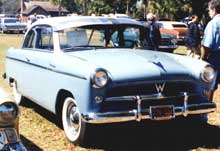The Short Flight of Aero Willys
The name "Willys" conjures up thoughts of Jeeps and their many variations, not ordinary passenger cars. This is despite the fact that the Jeep's ancestor, the Overland, was second only to Ford from 1912 to 1918, and that until World War II Willys trucks were relatively rare. The company's Whippet was the third-best selling car in 1928, and in 1933 all large cars like the Willys-Knights were ditched in favor of the compact and low-priced Willys 77, which progressed through several stages, the last of which were called "Americar." Trucks during this period comprised pickup versions of the cars.
After the war, Willys had hopes of returning to cars. In fact, some attractive designs were penned by designer Brooks Stevens and a prototype sedan was built. However, the difficulties of resuming production dictated concepts that were simple to manufacture, and so the perpendicular wagons (another Stevens design)were the closest thing to cars to emanate from the Toledo factories. Later on, of course, came the sporty Jeepster, a passenger car for sure.
Model year 1952 marked Willys-Overland's return to cars. Styled by Phil Wright, whose prior art included the Pierce Silver Arrow and the 1935 Ford, and engineer Clyde Paton, the new Aero model was a small (108-inch wheelbase) unibody car with lots of interior room. There were three series, entry-level Lark, mid-range Wing and top-of-the-line Ace, the latter with a wrap-around rear window. An Eagle hardtop coupe was added in mid-year, with its own upmarket interior. Powered by the Willys 161 cid six-cylinder engines (L-head in the Lark, F-head in Wing and Ace), the cars were decent performers, and cheaper, though less well appointed, than Nash's Rambler.
For 1953, a Falcon series was added above Lark, and four-door models became available in all series. In 1954, cars got new taillights and bumper guards. The Falcon was dropped and Deluxe, Custom and Special trim levels were added.
Willys Motors was acquired by Henry J. Kaiser during 1953. Kaiser was mostly after the Jeeps, but a spiffed-up Aero was trotted out for 1955, the hardtop now called "Bermuda." After some 6,000 cars were sold the dies were shipped to Brazil, where, with new Brooks Stevens sheet metal, production continued until 1972. Thereafter, however, the closest thing to a passenger car to emanate from Willys in the USA was the Wagoneer.

